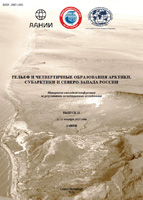| ||
|
| ||
|
doi: 10.24412/2687-1092-2024-11-87-94 1Arctic and Antarctic Research Institute, St. Petersburg, Russia
|
|
Abstract. The analysis of the present-day distribution of ice-dammed lakes on Svalbard shows that they often form when a glacier branch receives less accumulation and melts faster than the main glacier body. This pattern should have been repeated during the degradation of the Weichselian ice sheet. Ice-dammed freshwater lakes would form in valleys where two adjoining glaciation basins had a sharp difference in the mass balance due to differences in height, valley configuration or position relative to the precipitation source. Such difference today is observed in several regions of Svalbard and there are at least 4 valleys in Nordenskjold land where large ice-dammed lakes and “wet-valley” oases must have been formed during the deglaciation of the Late Weichselian ice sheet and where lacustrine conditions changed to marine only after the damming glacier retreat. Thus lacustrine or glacio-lacustrine sediments (with the addition of clastic materials from lake icebergs) should underlay marine fjord deltaic strata in lower Grondalen, Gronfjorddalen, Sassendalen and Kjellstromdalen as well as few other valleys of Nordenskjold land. Some of the ridges in lower parts of Svalbard valleys may represent Late Weichselian marginal moraines of the damming glaciers. During the melting of the Weichselian glaciation many dozens of dammed lakes must have existed simultaneously, some of which were significantly larger than the modern ones. Corresponding deposits of lakes and oases will have carbon dates exceeding full deglaciation. Keywords: glacier degradation, last glacial maximum, glacial mass balance, lacustrine sediments, Quaternary, Weichselian glaciation
REFERENCES: Glaciology of Spitsbergen. ed. Kotlyakov V.M., Nauka. 1985. 200 p. Romashova K.V., Chernov R.A. Inventory methodology of periglacial lakes in Spitzbergen (Svalbard) // Arctic and Antarctic Research. 2023. Vol. 69. Is. 2. P. 157-170. (in Russ.) doi: 10.30758/0555-2648-2023-69-2-157-170 Semevsky D.V., Shkatov E.P. Geomorfologiya Zemli Nordenshelda (Zapadny Shpitsbergen) // Materialy po geologii Shpitsbergena. L. 1965. P. 232-240 Soloveva D.A., Savelieva L.A., Verkulich S.R., Zazovskaya E.P. Poslelednikovyie izmeneniya prirodnoy sredy v rayone poselka Barentsburg (ostrov Zapadny Shpitsbergen) // «Theory and Methods of Polar Science: Proceedings of International youth scientific conference on the polar geodesy, glaciology, hydrology and geophysics. St. Petersburg, Russia, 17–19 May 2018» / ed. Popov S.V., Gavrilkina S.A., Pryakhina G.V. Saint-Petersburg, 2018. P. 213-222. Troitski L.S., Zinger E.M., Koryakin V.S., Markin V.A., Mikhalev V.I. Oledenenie Shpitsbergena (Svalbarda). M. Nauka. 1975. 276 p. Bondevik S., Mangerud J., Salvigsen O. Postglacial sea-level history of Edgeøya and Barentsøya, eastern Svalbard // Polar Research. 1995. Vol. 14. Is. 2. P. 153-180. doi:10.3402/polar.v14i2.6661. Farnsworth W.R., Allaart, L. et al. Holocene glacial history of Svalbard: Status, perspectives and challenges // Earth-Science Reviews. 2020. Vol. 208. doi:10.1016/j.earscirev.2020.103249 Forman S.L., Lubinski D., Ingólfsson O., Zeeberg J.J., Snyder J.A., Siegert M., Matishov G. A review of postglacial emergence on Svalbard, Franz Josef Land and Novaya Zemlya, northern Eurasia // Quaternary Science Reviews. 2004. Vol. 23. Is. 11–13. P. 1391-1434. doi:10.1016/j.quascirev.2003.12.007 Gilbert L.G. Cryostratigraphy and sedimentology of high-Arctic fjord valleys. PhD Thesis. University of Bergen, 2018. P. 1-28. Hanssen-Bauer I., Førland E., Hisdal H., Mayer S., Sandø A., Sorteberg A., Adakudlu M., Andresen J., Bakke J., Beldring S., Benestad R., van der Bilt W., Bogen J., Borstad Ch., Breili K., Breivik O., Børsheim K., Christiansen H., Dobler A., Wong W. Climate in Svalbard 2100 - a knowledge base for climate adaptation. NCCS report. 2019. no. 1. 208 p. doi:10.13140/RG.2.2.10183.75687. Landvik J., Ingólfsson Ó., Mienert J., Lehman S., Solheim A., Elverhøi A., Ottesen D. Rethinking Late Weichselian ice sheet dynamics in coastal NW Svalbard // Boreas. 2005. Vol. 34. P. 7-24. doi:10.1080/03009480510012809 Larsen E. et al. Lateglacial and Holocene glacier activity in the Van Mijenfjorden area, western Svalbard // Arktos. 2018. Vol. 4. Is. 1. P. 1–21. doi:10.1007/s41063-018-0042-2 Mangerud J., Bolstad M., Elgersma A., Helliksen D., Landvik J.Y., Lønne I., Lycke A.K., Salvigsen O., Sandahl T., Svendsen J.I. The Last Glacial Maximum on Spitsbergen, Svalbard // Quaternary Research. 1992. Vol. 38. Is. 1. P. 1–31. doi: 10.1016/0033-5894(92)90027-G Rowan D.E., Péwé T.L., Péwé R.H., Stuckenrath R. Holocene Glacial Geology of the Svea Lowland, Spitsbergen, Svalbard // Geografiska Annaler: Series A, Physical Geography. 1982. Vol. 64. Is. 1–2. P. 35–51. doi:10.1080/04353676.1982.11880055 Wieczorek I. Modern classification of Glacial Lakes Systems on Svalbard // The 7th annual: Students in Polar and Alpine Research Conference – SPARC 2021At: BrnoAffiliation: University of Wroclaw. 2021. doi:10.13140/RG.2.2.29816.87041. Wieczorek I., Strzelecki M.C., Stachnik Ł., Yde J.C., Małecki J. Post-Little Ice Age glacial lake evolution in Svalbard: inventory of lake changes and lake types // Journal of Glaciology. 2023. Vol. 69(277). P. 1449-1465. doi:10.1017/jog.2023.34
|
|
Cite this article: Demidov V.E., Terekhov A.V. Distribution of Late Pleistocene ice-dammed lakes and ice-free oases on Svalbard // Relief and Quaternary deposits of the Arctic, Subarctic and North-West Russia. 2024. Issue 11. P. 87-94. doi: 10.24412/2687-1092-2024-11-87-94
|

